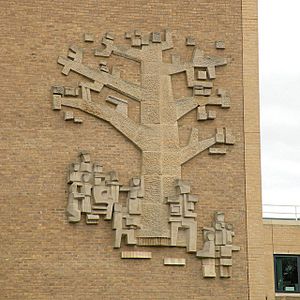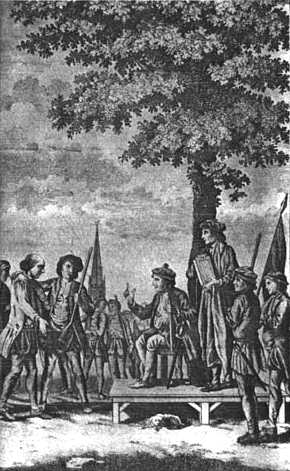Kett's Rebellion facts for kids
Quick facts for kids Kett's Rebellion |
|||||||
|---|---|---|---|---|---|---|---|
|
An 18th-century depiction of Robert Kett and his followers under the Oak of Reformation on Mousehold Heath |
|||||||
|
|||||||
Kett's Rebellion was a big uprising in Norfolk, England in 1549. It happened when King Edward VI was on the throne. The main reason for the rebellion was a problem called enclosure. This was when rich landowners fenced off shared land for their own use.
The rebellion started on July 8, 1549, in Wymondham. A group of angry people began tearing down fences. One of their targets was a farmer named Robert Kett. But instead of fighting them, Kett agreed with their complaints. He even offered to lead them!
Kett and his followers grew in number, reaching about 16,000 people. They set up a camp on Mousehold Heath, near Norwich, on July 12. On July 29, the rebels bravely entered and took control of Norwich. A few days later, on August 1, they even defeated a royal army sent to stop them. This army was led by the Marquess of Northampton.
The rebellion finally ended on August 27, 1549. The rebels were defeated by a larger army led by the Earl of Warwick at a place called Dussindale. Robert Kett was captured and later executed on December 7, 1549.
Why Did Kett's Rebellion Happen?

The 1540s were a tough time for farming in England. Most people relied on the land to live. This led to many protests across the country. Kett's Rebellion in Norfolk was the most serious of these.
The biggest problem was enclosure. This meant wealthy landowners were fencing off common land. This land was traditionally used by everyone to graze their animals. When it was fenced off, poor farmers had nowhere for their livestock.

Some landowners also forced tenants off their farms. They wanted to combine smaller farms into bigger ones. They also changed land used for crops into pastures for sheep. Raising sheep for wool had become very profitable.
Life was hard for ordinary people. Prices were going up, but wages were not. Many people lost their jobs, and rents increased. All these problems made people very angry and led to the rebellion.
How Is Kett's Rebellion Remembered Today?
Kett's Rebellion is still remembered in the Norwich and Wymondham areas. You can find schools, streets, and even pubs named after it. There is also a walking route that follows parts of the rebels' journey.
The story of Kett's Rebellion has appeared in many books. In 1988, a British composer named Malcolm Arnold wrote a piece of music. It was called the Robert Kett Overture (Opus 141) and was inspired by the rebellion.
Images for kids
-
Kett's Rebellion is remembered on Wymondham's town sign.
-
An early 19th-century painting of Mousehold Heath by local artist John Crome.
-
Norwich at the time of Kett's Rebellion.






